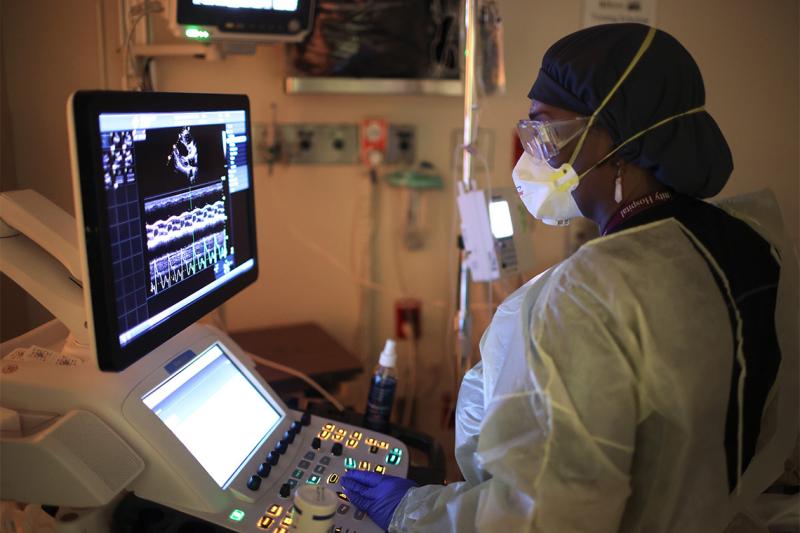January 28, 2021 | Alumni
Startup built by U of T alumni aims to reduce wait times for echocardiograms
By Alisa Kim

Cloud-based software developed by U of T alumnus Santiago Luna (MHI 2019) helps sonographers write summaries of echocardiograms for cardiologists, shaving as much as five minutes of the time needed to produce a report (photo by Scott Olson via Getty Images)
As a student in the executive master of health informatics (EMHI) program at the University of Toronto’s Institute of Health Policy, Management and Evaluation, Santiago Luna (MHI 2019) was tasked with a project: come up with an idea to use information technology to improve health outcomes. So, he drew on his experience as a sonographer specializing in echocardiograms, an ultrasound exam that checks the structure and function of the heart.

With the help of fellow alumni of the program Oliver Tsai (BA 1993 TRIN, MHI 2019) and Prabhdeep Dhaliwal (MHI 2019), Luna developed cloud-based software that works with any ultrasound machine and applies the latest clinical guidelines to anatomical measurements taken during an echocardiogram, or echo – a commonly prescribed test used to assess and diagnose diseases like heart failure. The software helps sonographers write a summary of the test to give to cardiologists.
Luna says that by shaving just five minutes off the time it takes to produce the report, the technology enables a sonographer to do 240 more echos per year. In jurisdictions like Manitoba, where the wait time for an echo is up to 18 months, the improved efficiency of the report-generating process could reduce wait times by one-third.
“It was only natural that [my] project would have to do with making the ultrasounds better in terms of workflow and process for both clinicians and patients,” Luna says.
Faster and simpler reporting improves report quality too, by making it easier to adhere to clinical guidelines
The software, which Luna describes as a clinical virtual assistant, processes the anatomical measurements against current clinical guidelines for echocardiograms and highlights, for example, any anatomical issues that may be of concern.
“Our technology automates the report, which makes the reporting a lot faster and simpler, and makes the adherence to clinical guidelines a lot higher. As a result, the quality of the report is significantly improved,” says Luna.
Currently, there is no way to know if sonographers are working with the most up-to-date clinical echo guidelines, much less enforce their use.
Luna says that, like other medical specialties, it’s difficult to stay abreast of all the latest research.
“When you train as a sonographer or cardiologist, there’s a massive amount of information [to learn]. You study a lot and 10 years later, you’re practising and still using the same guidelines from 10 years ago. When new guidelines come out, you get a continuing education credit, but it’s not practical to implement into practice.”
He emphasizes that the tool does not replace the clinician. “We are not telling the cardiologist or clinician what they should be diagnosing or what the diagnosis is,” he says. “What we’re doing is putting the information they need at their fingertips so that they can do what clinicians do: take better images and make a diagnosis, which is what they’re good at.”
With Dhaliwal and Tsai, he is commercializing the software. They’ve named the product Augmented Reporting and have formed a company. Their efforts to move the technology to the medical marketplace are bolstered by seed money from the Lo Family Social Venture Fund, which will enable them to hire people to accelerate development of the tool.
“Technology should free clinicians’ time so they can do what they’re supposed to be doing”
Luna says that the EMHI program provided vital training to get the venture off the ground.
“Julia Zarb, the program director at the time, was instrumental in encouraging me, shaping the idea, and letting me run wild with my imagination while keeping me in line with what the future stakes would need to be,” he says. “The program gave me the foundational knowledge I needed – from project management to IT fundamentals. On top of that, it connected me with my co-founder and partner, Oliver Tsai. Without him, this would not be what it is right now.”
Luna says the ultimate goal is to share the tool as widely as possible to enable better and more equitable cardiac care.
Luna envisions the software being used in rural areas, for example, where there is less access to cardiology expertise, so that the quality of echos done in these areas is on par with that of echos done in big cities.
“The hope is to have a sustainable product that can make enough profit in metropolitan areas to subsidize the areas that do not have the resources to get something like this. The idea is to have technology do what it should do for clinicians: free their time so they can do what they’re supposed to be doing: diagnosing and doing medicine. That’s my hope.”

